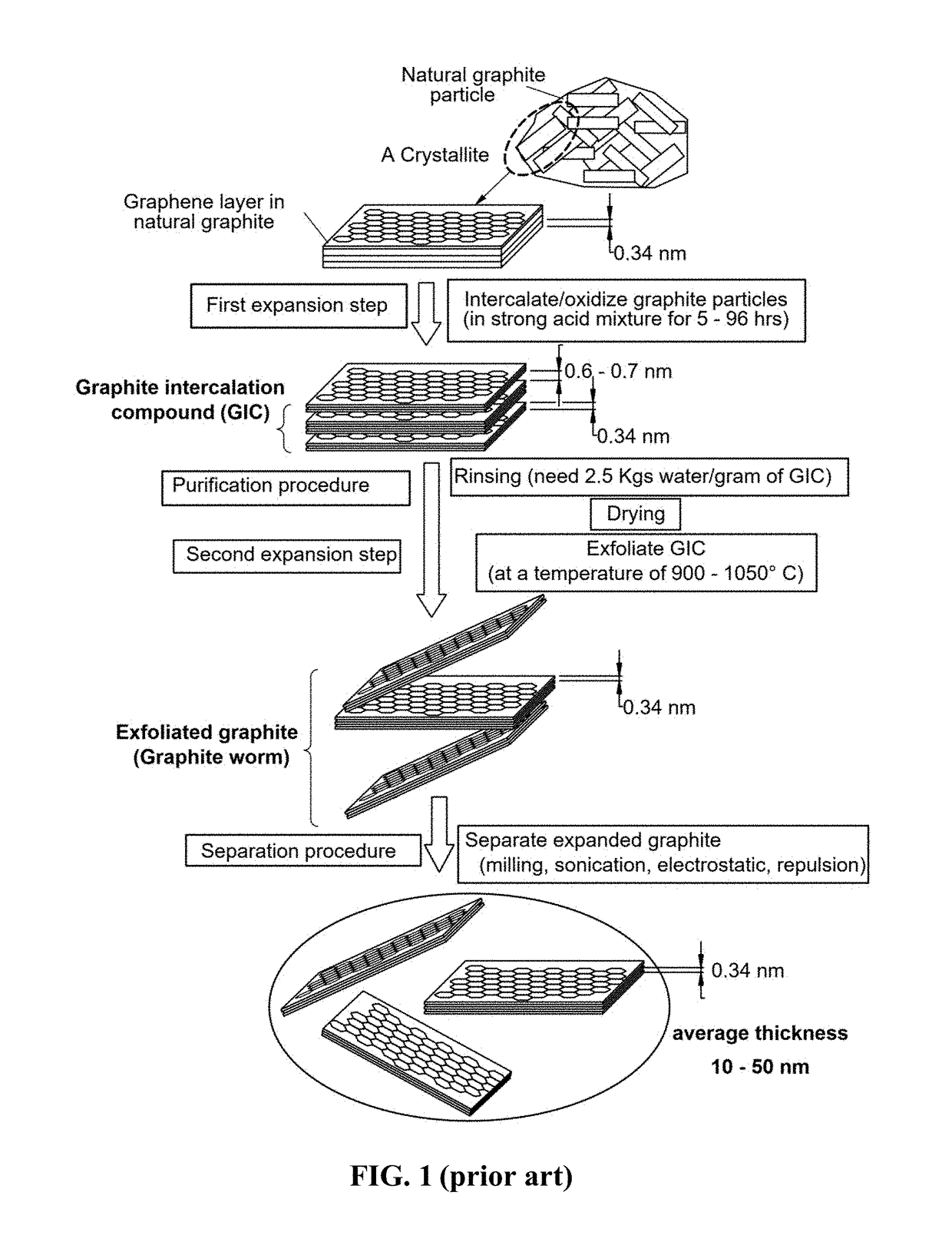Production of graphene materials directly from carbon/graphite precursor
a graphene and precursor technology, applied in the field of graphene materials, can solve the problems of high energy consumption of the process, inability to mass produce ngps, and inability to meet the mass production of ngps, and achieve the effect of good interfacial bonding and effective reinforcement fillers
- Summary
- Abstract
- Description
- Claims
- Application Information
AI Technical Summary
Benefits of technology
Problems solved by technology
Method used
Image
Examples
example 1
Isolated Graphene Sheets from Naphthalene
[0085]Isolated graphene sheets were produced from heat treated naphthalene by executing the following procedure: (a) pouring a mass (100 grams) of naphthalene into a stainless steel reactor (5 gallon size); (b) heating the reactor from 150° C. to 450° C. at a rate of 2 degrees per minute and subsequently maintaining the temperature at 450° C. for 4 hours under mechanical shearing conditions (shear rate >100 sec−) to obtain individual graphene planes and graphene domains well-dispersed in a disordered matrix of carbon or hydrocarbon molecules, and (c) pouring 2 gallons of quinolone into the heat-treated mass to dissolve the disordered hydrocarbon molecules, allowing graphene sheets or graphene domains to be suspended as an insoluble component in the quinolone liquid. The insoluble component in the resulting suspension is then isolated by solid-liquid separation (filtration) to become isolated single-layer graphene sheets or few-layer graphene ...
example 2
Functionalized Graphene Sheets from Anthracene
[0088]A mass (100 grams) of anthracene was into a stainless steel reactor pre-set at a temperature of 350° C., which was subsequently maintained at the same temperature for 3 hours. Subsequently, diethylenetriamine (DETA) was added and the material mixture was processed at 450° C. for an additional 2 hours under ultrasonication conditions (80-400 W) to obtain amine-functionalized graphene planes and graphene domains well-dispersed in a disordered matrix of hydrocarbon molecules.
[0089]In separate experiments, the following functional group-containing species were separately introduced to the aromatic mass being heat-treated: an amino acid, sulfonate group (—SO3H), 2-Azidoethanol, polyamide (caprolactam), and aldehydic group. In general, these functional groups were found to impart significantly improved interfacial bonding between resulting graphene sheets and epoxy, polyester, polyimide, and vinyl ester matrix materials to make stronger ...
example 3
Isolated Graphene Sheets from other Polycyclic Aromatic Hydrocarbon molecules
[0090]Various PAHs were used as a starting material for producing graphene through the presently invented method. The representative processing conditions and products are summarized in Table 1 below:
TABLE 1Representative processing conditions and some salient features of products.GrapheneSampleAromatic2nd heatChemical ortype orIDmolecules1st heat treatmenttreatmentmechanicalthicknessPh-1Phenanthrene250° C. 2 h + 350° C. 3 h600° C., 3 hUltrasonicationMostlysingle-layerPh-2Phenanthrene250° C. 2 h + 350° C. 3 h600° C., 3 hNone5-15 layersTc-1Tetracene300° C. 2 h + 400° C. 3 h900° C., 3 hHigh shear1-layer &few-layerTc-2Tetracene300° C. 2 h + 400° C. 3 h900° C. 3 hNone7-20 layersTc-3Tetracene300° C. 2 h + 400° C. 3 h900° C. 3 h +UltrasonicationFew-layer1500° C. 2 h(at graphenePy-1Pyrene400° C. 5 hNoneAryl silaneSingle-layerPy-2Pyrene400° C. 5 hNoneNone5-10 layersCn-1Coronene450° C. 5 hNone2-AzidoethanolSingle-la...
PUM
| Property | Measurement | Unit |
|---|---|---|
| Temperature | aaaaa | aaaaa |
| Temperature | aaaaa | aaaaa |
| Temperature | aaaaa | aaaaa |
Abstract
Description
Claims
Application Information
 Login to View More
Login to View More - R&D
- Intellectual Property
- Life Sciences
- Materials
- Tech Scout
- Unparalleled Data Quality
- Higher Quality Content
- 60% Fewer Hallucinations
Browse by: Latest US Patents, China's latest patents, Technical Efficacy Thesaurus, Application Domain, Technology Topic, Popular Technical Reports.
© 2025 PatSnap. All rights reserved.Legal|Privacy policy|Modern Slavery Act Transparency Statement|Sitemap|About US| Contact US: help@patsnap.com



